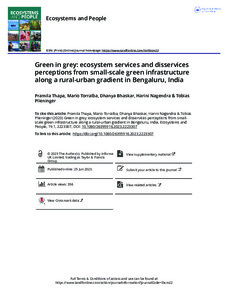| dc.date.accessioned | 2023-07-03T16:26:51Z | |
| dc.date.available | 2023-07-03T16:26:51Z | |
| dc.date.issued | 2023-06-25 | |
| dc.identifier | doi:10.17170/kobra-202307038323 | |
| dc.identifier.uri | http://hdl.handle.net/123456789/14865 | |
| dc.description.sponsorship | Gefördert durch den Publikationsfonds der Universität Kassel | |
| dc.language.iso | eng | |
| dc.rights | Namensnennung-Nicht-kommerziell 4.0 International | * |
| dc.rights.uri | http://creativecommons.org/licenses/by-nc/4.0/ | * |
| dc.subject | multifunctionality | eng |
| dc.subject | photoelicitation | eng |
| dc.subject | socio-economic preferences | eng |
| dc.subject | trees | eng |
| dc.subject | urbanization | eng |
| dc.subject.ddc | 570 | |
| dc.title | Green in grey: ecosystem services and disservices perceptions from small-scale green infrastructure along a rural-urban gradient in Bengaluru, India | eng |
| dc.type | Aufsatz | |
| dcterms.abstract | Ecosystem services provided by green infrastructure are often discussed for their potential to address the societal challenges of urbanization. However, green infrastructure, particularly small-scale types (e.g. trees), is vulnerable to loss through urbanization and is often passed over during scientific investigations. Studies on the perceptions of ecosystem services and disservices (hereafter called ecosystem (dis)services) dynamics along the ruralurban gradient are particularly rare in the literature. Therefore, this study assessed the perceived importance of ecosystem (dis)services associated with small-scale green infrastructure along a rural-urban gradient in Bengaluru, India. Based on photos of the five most common types of small-scale green infrastructure and the three most common tree species associated with them, we conducted a photo-elicitation survey of 649 residents from 61 towns in Bengaluru. We found significant differences in the perceptions of all ecosystem (dis)services among the types of green infrastructure. The most appreciated services were air/climate regulation from platform trees and aesthetic values from farm trees. Regulating services were most appreciated in urban areas while provisioning and cultural services were most appreciated in transitional areas, and disservices were most strongly perceived in rural areas. Gender, age, education, caste, and income from agriculture significantly affected the use and valuation of the ecosystem (dis)services within the local communities. Our study reveals the crucial role of small-scale green infrastructure as a multifunctional element, which is highly relevant for the supply of provisioning, regulating, and cultural ecosystem services in Bengaluru. | eng |
| dcterms.accessRights | open access | |
| dcterms.creator | Thapa, Pramila | |
| dcterms.creator | Torralba, Mario | |
| dcterms.creator | Bhaskar, Dhanya | |
| dcterms.creator | Nagendra, Harini | |
| dcterms.creator | Plieninger, Tobias | |
| dc.relation.doi | doi:10.1080/26395916.2023.2223307 | |
| dc.subject.swd | Bangalore | ger |
| dc.subject.swd | Indien | ger |
| dc.subject.swd | Urbanität | ger |
| dc.subject.swd | Photoanregung | ger |
| dc.subject.swd | Baum | ger |
| dc.subject.swd | Multifunktionalität | ger |
| dc.type.version | publishedVersion | |
| dcterms.source.identifier | eissn:2639-5916 | |
| dcterms.source.issue | Issue 1 | |
| dcterms.source.journal | Ecosystems and People | eng |
| dcterms.source.volume | Volume 19 | |
| kup.iskup | false | |


